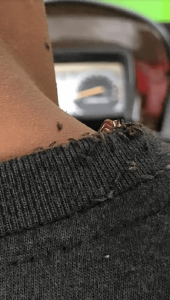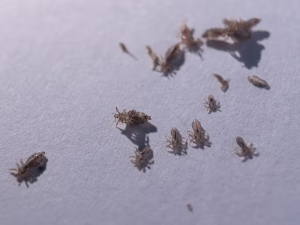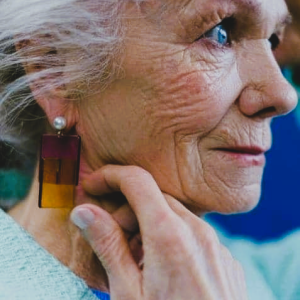In a world where shocking stories go viral every day, one recent incident has caught the attention of thousands. A tricycle driver in the Philippines became the subject of a now-deleted video showing a severe head lice infestation. The footage, originally shared by Facebook user Primo Onipa, sparked widespread concern among netizens and served as a reminder of the importance of personal hygiene—especially for those in constant contact with the public.
Let’s dive into this unsettling story and understand the dangers of untreated lice infestations, the potential health implications, and how to effectively prevent and treat this common yet often overlooked issue.

The Shocking Footage That Went Viral
The video, which quickly made the rounds on social media before being removed, showed lice visibly crawling across the back of the tricycle driver’s neck and even onto his shirt. This wasn’t just a mild case—it was an extreme infestation that left viewers both horrified and deeply concerned.
The uploader, Primo Onipa, aimed to use the video as an educational moment, urging people—especially fellow tricycle drivers—to prioritize hygiene. His message was clear: maintaining cleanliness isn’t just about personal health; it’s also about protecting those around you, particularly in professions where interaction with the public is a daily occurrence.
Expert Insights on the Health Risks of Head Lice
While lice infestations are often dismissed as a minor inconvenience, experts warn that severe cases can lead to significant health problems. Dr. Jay Recasata of Faces and Curves Clinic explained the seriousness of untreated lice infestations.
How Lice Thrive: “Head lice thrive at the roots of our hair,” Dr. Recasata shared. They feed on blood from the scalp, multiply rapidly, and can cause intense discomfort.
Potential Health Complications: When left untreated, lice can lead to open wounds on the scalp. These wounds can become infected with bacteria, escalating the health risks. In extreme cases, as noted by Dr. Enrique Collantes from Derma Clinic, severe lice infestations can even result in anemia or malnutrition due to the lice feeding on their host’s blood.
The Cost of Treatment: Affordable and Effective Solutions
The good news? Treating head lice is neither complicated nor expensive. According to Dr. Recasata, specialized shampoos designed to eliminate lice are readily available for around P500 (approximately $10). These shampoos are effective when used correctly and consistently.
However, the real challenge lies in identifying the infestation early and taking prompt action. Severe cases like the one seen in the viral video are often the result of neglect or lack of awareness.
How Lice Spread: Understanding the Contagion
Head lice are highly contagious, spreading primarily through direct contact. Whether it’s a shared comb, hat, or even a hug, lice can transfer from one person to another with ease. Here’s how they proliferate:
Personal Items: Sharing combs, brushes, hats, or scarves with an infected person can easily transfer lice.
Shared Spaces: Lice can survive temporarily on upholstered furniture, bedding, and towels, further increasing the chances of spreading.
Close Contact: Activities like hugging or sitting close to someone with an infestation can also lead to transmission.
This highlights the importance of maintaining hygiene, especially in shared or public spaces.
Prevention Tips: Keeping Lice at Bay
Preventing a lice infestation requires a combination of good hygiene habits and proactive measures. Here are some expert-recommended tips:
Regular Hair Washing: Use mild shampoos and conditioners regularly to keep your scalp clean.
Avoid Sharing Personal Items: Never share combs, brushes, hats, or towels.
Sanitize Bedding and Clothing: Wash clothes, bedding, and pillowcases in hot water to kill any lurking lice or eggs.
Disinfect Brushes and Combs: Soak them in hot water for at least 5–10 minutes after every use.
Vacuum Your Home: Lice can live briefly on furniture and carpets, so regular vacuuming is essential.
For individuals in high-contact professions, like drivers, teachers, or healthcare workers, these preventive measures are even more critical.

A Broader Message About Hygiene Awareness
This story goes beyond head lice—it’s a reminder of the importance of maintaining personal hygiene for everyone’s health and well-being. In the case of tricycle drivers and other public-facing professions, hygiene is not just a personal matter; it’s a public responsibility.
Regular self-care, paired with awareness of potential risks, can help prevent situations like the one in the viral video. By staying vigilant and addressing health issues early, we can protect ourselves and those around us.
Netizens React: Empathy and Awareness
The viral video sparked a mix of reactions online. While some expressed shock and disgust, others were quick to show empathy. Many highlighted the need for increased awareness and access to affordable healthcare solutions, especially for those in low-income professions.
This incident serves as a wake-up call to prioritize health education and ensure that preventive measures are accessible to everyone, regardless of their circumstances.
Conclusion
The story of the tricycle driver with an extreme head lice infestation is more than just a viral sensation—it’s a powerful reminder of the importance of hygiene, awareness, and timely treatment. Head lice might seem like a minor nuisance, but when left untreated, they can lead to severe health complications and impact quality of life.
By understanding how lice spread, taking preventive measures, and addressing infestations early, we can avoid such extreme cases and promote a healthier, more hygienic environment for everyone. Let this story inspire us to stay vigilant and prioritize our well-being—because even the smallest creatures can cause big problems if left unchecked.
Have you ever dealt with head lice? What was your experience like? Share your thoughts and tips in the comments below!





